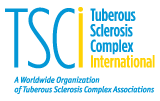Skin
Individuals with tuberous sclerosis complex (TSC) often see the disease manifested in the skin, including on the face, body and nails. In some cases, skin growths can become obtrusive but in most cases, the growths themselves are harmless. However manifestations such as facial angiofibromas can have a social impact and treatments are available.
Manifestations
Skin lesions resulting from TSC include:
- hypomelanotic macules—patches of skin lighter than the surrounding skin (can be any size or shape or may be the classic “ash-leaf” shape)
- shagreen patch—a patch of skin that is tough and dimpled like an orange peel
- periungual or subungual fibromas—fibrous growths that appear around the fingernails and toenails; and
- facial angiofibromas—tumors of the face
Fibrous plaques sometimes appear on the forehead of individuals with TSC. There may also be fibrous, hairless scalp plaques surrounded by thin, white tufts of hair.
Occasionally an individual with TSC coincidentally will have café au lait spots (areas of skin darker than the surrounding skin, but lighter and usually larger than a mole), but these skin lesions are not diagnostic of TSC. A child with three or more or an adult with five or more café au lait spots may be diagnosed with neurofibromatosis, another genetic condition.
Diagnostic screening and follow-up treatment
At the initial testing, the physician uses a Wood’s lamp (an ultraviolet light) to better visualize the hypomelanotic macules—white patches on the skin that often are difficult to see, especially on infants and people with very pale skin. The entire body should be examined. The skin should be carefully examined for the other skin manifestations of TSC as well.
Some of the skin signs may not be present at birth; the facial angiofibromas do not usually appear until between the ages of 3 and 5 at the earliest, and the periungual and subungual fibromas do not usually occur until much later in life. Lesions that appear later should be noted and brought to the attention of the physician.
Treatment options for skin involvement
The most often treated skin manifestations of tuberous sclerosis complex (TSC) are the facial angiofibromas and periungual and subungual fibromas. The facial angiofibromas can be removed using dermabrasion or laser treatment; these procedures should not be considered cosmetic surgery because they treat tumors resulting from a genetic condition. Research has suggested that the facial angiofibromas should be removed (using laser treatment) when they are small, before they enlarge and become fibrous. They most likely will recur and need further treatment, but they will be milder than if left untreated. Recent studies have shown that topical rapamycin may be a promising treatment for Angiofibromas. When treatment is started while angiofibromas are small, it will likely reduce the need for laser treatment in the future
Individuals with TSC, who are interested in treatment, should see a dermatologist or a plastic surgeon that specializes in laser surgery. When screening for doctors, make sure they are qualified surgeons who have experience dealing with medical skin conditions.
Some cosmetic companies also manufacture makeup to cover hypomelanotic macules if they are large or in exposed areas of the skin. For some individuals, the hypomelanotic macules are not problematic, whereas others will chose to cover them with clothing or makeup.
TOPICAL RAPAMYCIN LETTER OF MEDICAL NECESSITY [MS WORD]
SKIN FEATURES OF TSC [PDF]
This information © of the Tuberous Sclerosis Alliance and used with permission 2014. All rights reserved.

